

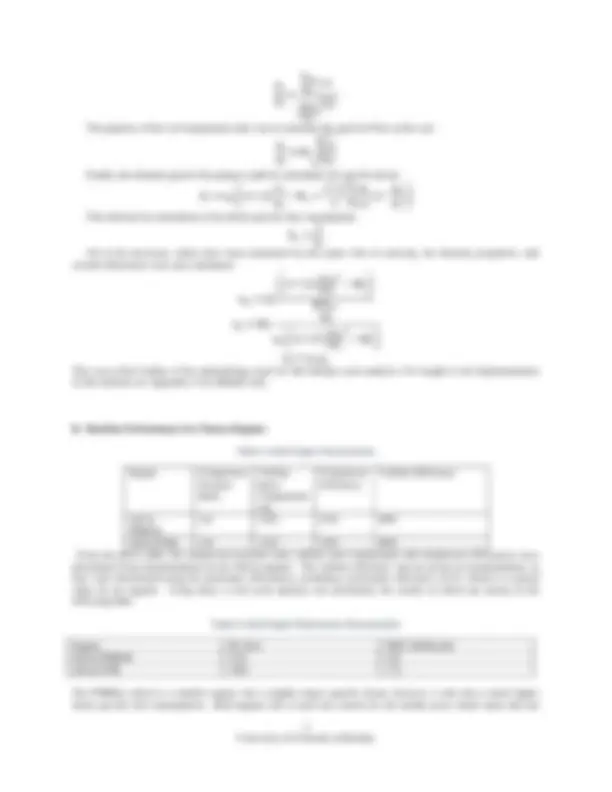
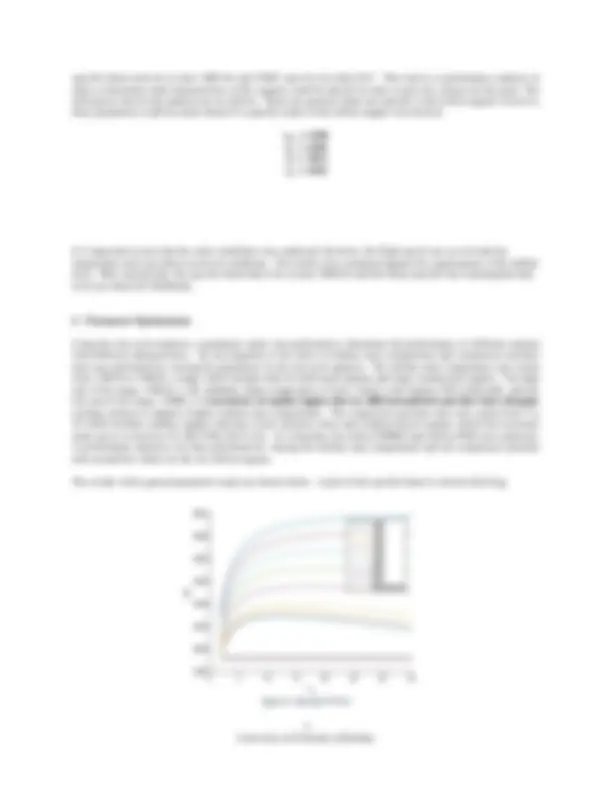
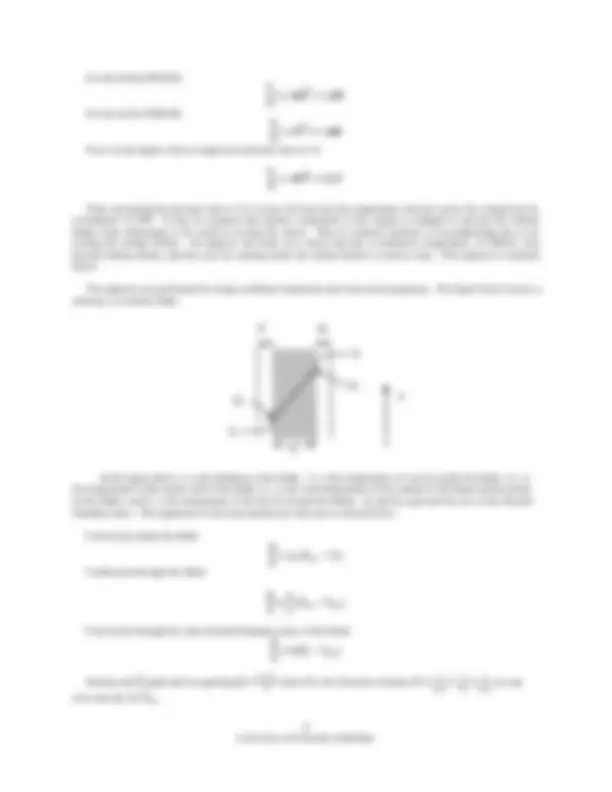
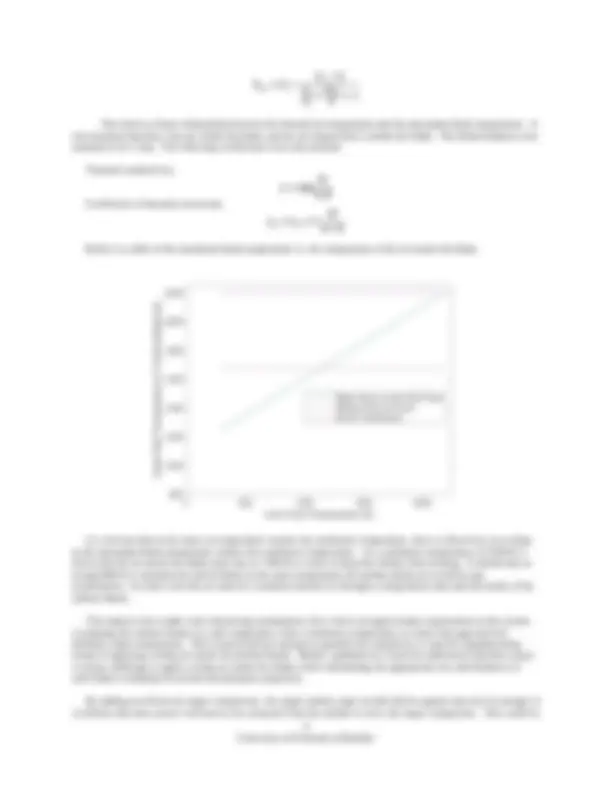
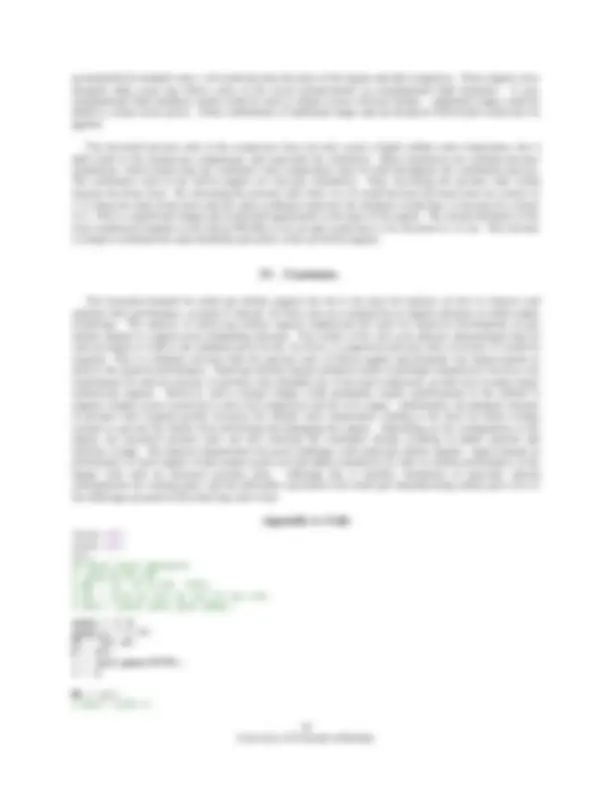



Study with the several resources on Docsity

Earn points by helping other students or get them with a premium plan


Prepare for your exams
Study with the several resources on Docsity

Earn points to download
Earn points by helping other students or get them with a premium plan
Community
Ask the community for help and clear up your study doubts
Discover the best universities in your country according to Docsity users
Free resources
Download our free guides on studying techniques, anxiety management strategies, and thesis advice from Docsity tutors
An analysis of small gas turbine engines, focusing on their design, challenges, and optimization for improved efficiency. an explanation of engine components, calculations for pressure and temperature ratios, and a parameter study to determine the effect of turbine entry temperature and compressor pressure ratio on engine performance. The ultimate goal is to meet specific thrust and thrust specific fuel consumption requirements set by the Air Force for small turbine engines.
Typology: Summaries
1 / 13

This page cannot be seen from the preview
Don't miss anything!








Nathan Genrich,^1 Crawford Leeds,^2 and Tyler Smith^3 University of Colorado, Boulder, CO, 80503
This paper serves to provide an analysis on small, thrust producing, gas turbine engines to provide a foundation to future development on engine efficiency. Small gas turbines have been employed on a relatively small market of government unmanned aircraft and hobbyists with loose fuel consumption requirements. In the past decade large gas turbine engines for private and commercial aircraft have decreased thrust specific fuel consumption by approximately 20%. A significant driver of this is the increased cost of fuel and consumers’ demand for low airfare. Until recently the small turbine market has been too small to demand high fuel efficiency. Advances to the autonomous and unmanned aircraft industry has increased demand for relatively small aircraft. Operators are now managing a much larger fleet and therefore can find large cost savings from increasing fuel efficiency. Extended unmanned aircraft operations has also become increasingly valuable for military reconnaissance. Now that there is potential for large cost savings with increasing fuel efficiency, the United States Air Force is pursuing a competition for an ultra-efficient jet engine for unmanned aircraft applications. The conclusion of this paper will describe the shortfalls of current small aircraft and the critical components that can contribute to meeting the competitions strict requirements.
a = Speed of sound CFD = Computational Fluid Dynamics Cpc = Compressor specific heat at constant pressure Cpt = Turbine specific heat at constant pressure f = Fuel-to-air ratio hpr = Fuel heating value M = Mach number P = Pressure Pt = Stagnation pressure Rc = Compressor gas constant of air Rt = Turbine gas constant of air ST = Specific thrust Sfc = Thrust specific fuel consumption T = Temperature Tt = Stagnation temperature u = Flow velocity 𝜂 = Efficiency 𝛾𝑐 = Ratio of specific heats in compressor 𝛾𝑡 = Ratio of specific heats in turbine 𝜋 = Pressure ratio 𝜏 = Temperature ratio
(^1) BS/MS Student, Aerospace Engineering Sciences (^2) BS/MS Student, Aerospace Engineering Sciences (^3) BS/MS Student, Aerospace Engineering Sciences
MALL gas turbine engines are a field that has high growth potential but has not been fully explored yet. However, the Air Force has recently put out a challenge to develop a small, high efficiency turboprop or turboshaft engine for small unmanned aerial vehicles. The recent enormous increase in the drone market due to military demand makes such an endeavor potentially very profitable. Currently, the majority of the unmanned aerial systems employed by the US military are powered by internal combustion engines. Examples of this include the General Atomics Predator and Reaper. Although there are gas turbine engine-powered unmanned vehicles, it is a largely unexplored market because of the inefficiencies and poor performance associated with small-scale gas turbine engines.
There are a number of problems associated with small gas turbine engines which make them perform worse in terms of both efficiency and total thrust/power. Beyond the fact that there has only been recent demand for high- performance micro engines, technical problems such as cooling, manufacturing of small parts, limited configurations for rotating parts, and many other issues have to be dealt with.
With this in perspective, the goal of this project was to determine how to alter parameters of a set of already- existing small-scale gas turbine engines in order to meet performance requirements set out by the Air Force challenge. On top of this, technologies were researched that could potentially make such an improvement in performance possible.
The Air Force challenge outlines several requirements for small engines. Several pertinent requirements have been compiled in Table 1 below: Table 1: Air Force challenge parameters Variable Value Fuel type Jet A fuel Power output 50 bhp – 150 bhp max continuous output BSFC 0.55 lbm/bhp-hr Specific power 2.0 bhp/lb Maximum weight 75 lb
Note that these values, especially the BSFC and specific power, seem like extremely easily achievable goals for an engine. [1] provides a set of military turboprop and turboshaft engines and their known specifications. The team performed some calculations on this data set and found that the average specific power on this data set was 2. bhp/lb and the average BSFC was 0.562 lbm/bhp-hr. Both of these values barely exceed the requirements set out by the challenge. If an average performing turboprop engine can already exceed the specifications, it stands to reason that such a thing would be possible for small engines. Again, however, these specifications are difficult to meet due to technical problems and low technology readiness levels for such small machines.
The team did not focus on turboprop engines; rather, due to an interest in turbojets, these were used instead. Unfortunately, the metrics by which turboprops are measured are not the same metrics by which turbojets and turbofans are measured. In order to provide new metrics, a different scheme had to be decided upon. Notice how the average of the large-scale turboprop engines very nearly met the requirements for the small-scale engines. Because of this consideration, the team used a set from [1] describing large-scale military turbofan and turbojet engines. Over 1000 engines were analyzed from the database. Performing similar analysis on this data set, it was found that the average specific thrust for these engines was 1800 ft/s and the average TSFC was 0.873 (in English units). These averages for the large scale engines were used as a modified set of requirements for the new small-scale engine. The new requirements have been compiled in Table 2: Table 1: Modified challenge parameters Variable Value Fuel type Any TSFC 0.873 lbf/lbm-hr Specific thrust 1800 ft/s Maximum weight 75 lb
𝛾𝑡− 𝛾𝑡
The purpose of this exit temperature ratio was to calculate the speed of flow at the exit: 𝑢 9 𝑎 0
Finally, the ultimate goal of the project could be calculated: the specific thrust.
𝑆𝑇 = 𝑎 0 ((1 + 𝑓)
This allowed for calculation of the thrust specific fuel consumption. 𝑆𝑓𝑐 =
All of the necessary values have been calculated by this point. Out of curiosity, the thermal, propulsive, and overall efficiencies were also calculated:
2 − 𝑀∞^2 )
2𝑓ℎ𝑝𝑟
𝜂𝑝 = 2𝑆𝑇
2 − 𝑀 02 )
𝜂 0 = 𝜂𝑡ℎ𝜂𝑝 This was a brief outline of the methodology used for full turbojet cycle analysis. For insight to the implementation of this method, see Appendix A for Matlab code.
B. Baseline Performance for Chosen Engines
Table 1: JetCat Engine Characteristics
Engine Compressor Pressure Ratio
Turbine Entry Temperature (K)
Compressor Efficiency
Turbine Efficiency
JetCat P90RXI
JetCat P200 4.0 1325 44% 90% From the above table, the compressor pressure ratio, turbine entry temperature and compressor efficiencies were determined from documentation on the JetCat engines. The turbine efficiency was not given in documentation, so they were determined using the polytropic efficiencies, assuming a polytropic efficiency of 0.9, which is a typical value for jet engines. Using these, a real cycle analysis was performed, the results of which are shown in the following table
Table 2: JetCat Engine Performance Characteristics
Engine ST (ft/s) TSFC (lbf/lbm/hr) JetCat P90RXI 1531 1. JetCat P200 1462 1.
The P90RXI, which is a smaller engine, has a slightly larger specific thrust; however, it also has a much higher thrust specific fuel consumption. Both engines fail to meet the criteria for the turbine prize which states that the
specific thrust must be at least 1800 ft/s and TSFC must be less than 0.87. This lead to a performance analysis in order to determine what characteristics of the engines could be altered in order to meet the criteria for the prize. The efficiencies used in the analysis are as follows. These are general values not specific to the JetCat engines; however, these parameters could be easily altered if a specific study on the JetCat engines was desired.
𝜂𝑚 = 0. 𝜂𝑏 = 0. 𝜂𝑡 = 0. 𝜂𝑐 = 0.
It is important to note that the static conditions were analyzed; therefore, the flight speed was set to 0 and the temperature used was that at sea level conditions. The results were compared against the requirements of the turbine prize. More specifically, the specific thrust had to be at least 1800 ft/s and the thrust specific fuel consumption had to be less than 0.87 lbf/lbm/hr.
C. Parameter Optimization
Using the real cycle analysis, a parameter study was performed to determine the performance of different engines with different characteristics. An investigation of the effect of turbine entry temperature and compressor pressure ratio was performed by varying the parameters in the real cycle analysis. The turbine entry temperature was varied from 1300 K to 2400 K, a range which includes that for both small engines and large commercial engines. The high end of the range, 2400 K, is the adiabatic flame temperature of JetA, which is the highest TET achievable, and the low end of the range, 1300K, is characteristic of smaller engines that use different materials and don’t have adequate cooling systems to support a higher turbine entry temperature. The compressor pressure ratio was varied from 2 to 35 which includes smaller engines that have lower pressure ratios and commercial jet engines which have pressure ratios up to as much as 35 (GE F100, GE F118). As a baseline, the JetCat P90RXI and JetCat P200 were analyzed. A performance analysis was then performed by varying the turbine entry temperature and the compressor pressure ratio around the values for the two JetCat engines.
The results of the general parameter study are shown below. A plot of the specific thrust is shown following
Figure 1: Specific Thrust
Figure 3: Thrust Specific Fuel Consumption-Ideal Case
The figure shows that the compressor pressure ratio needed to meet the requirement for the turbine prize is much less than that for component efficiencies less than unity. Therefore, if work is done to improve the component efficiencies, the pressure ratio requirement could be met with fewer stages, therefore reducing size and weight.
D. Methods and Feasibility of Reaching Optimized Parameters
Almost all small commercially available jet turbine engines – including the JetCat P90-RXi and JetCat P200-SE
Large modern engines use almost exclusively axial compressors rather than centrifugal compressors. This requires multiple stages as the pressure ratio across each stage is less than it is for a centrifugal compressor. However, engines such as the Pratt and Whitney F100 has an overall pressure ratio of 35 and the GE F118 has an overall pressure ratio of 35.1. This proves than it is possible to have an axial compressor than can support pressure ratios above 15 as needed for this competition. It may be possible to have a multi stage compressor achieve the same compressor pressure ratio, but this is generally not considered practical due to the extremely large intake required and the efficiencies lost due to redirecting flow. Thus, a multi-stage axial compressor will be considered the most viable option for achieving a minimum overall pressure ratio of 15.
One of the first considerations in increasing the pressure is the increased temperatures found in the combustor, and therefore the turbines. The turbine blades are made of Inconel – an alloy of nickel containing chromium and iron. Inconel has a melting temperature of 1673 K. Currently the JetCat engines have a burner temperature around 1350 K. The maximum increase in temperature would be from assuming an isentropic relationship. Thus, the temperature increase corresponding to a pressure ratio of 2.6 and 15 can found using the following method.
𝛾− 𝛾
For the JetCat P90-RXi, 𝑇 2 𝑇 1
. 1.4 (^) = 1.
For the JetCat P200-SE 𝑇 2 𝑇 1
. 1.4 (^) = 1.
Now, for an engine with a compressor pressure ratio of 15,
𝑇 2 𝑇 1
. 1.4 (^) = 2.
Thus, increasing the pressure ratio to 15 or more will increase the temperature increase across the compressor by a minimum of 50%. It may be required that another component of the engine is changed to prevent the turbine blades from deforming to the point of seizing the motor. One of common methods of accomplishing this is by cooling the turbine blades. An analysis was done on a motor that has a combustor temperature of 2200 K, uses Inconel turbine blades, and has cool air rushing inside the turbine blades to remove heat. This analysis is outlined below.
The analysis was performed by using combined conduction and convection equations. The figure below shows a cutaway of a turbine blade.
In the figure above, L is the thickness of the blade. T 1 is the temperature of cool air inside the blade, Tw1 is the temperature of the inside wall of the blade, Tw2 is the wall temperature of the outside of the blade (hottest point on the blade), and T 2 is the temperature of the hot air around the blades. 𝛿 1 and 𝛿 2 represent the size of the thermal boundary layer. The equations for the heat transfer per unit area is shown below.
Convection inside the blade: 𝑄̇ 𝐴
Conduction through the blade:
𝑄̇ 𝐴
Convection through the outer thermal boundary layer of the blade: 𝑄̇ 𝐴
Setting each 𝑄̇ 𝐴 equal and recognizing^ 𝑄̇ =^
𝑇 2 −𝑇 1 𝑅 where R is the thermal resistance^ 𝑅 =^
1 ℎ 1 𝐴 +^
𝐿 𝐴𝑘 +^
1 ℎ 2 𝐴 we can solve directly for 𝑇𝑤2.
accomplished in multiple ways – all would increase the price of the engine and add complexity. These engines were designed many years ago before some of the recent advancements in computational fluid dynamics. A new computational fluid dynamics model could be used to obtain a more efficient turbine. Additional stages could be added to extract more power. Some combination of additional stages and an advanced CFD model could also be applied.
The increased pressure ratio in the compressor does not only create a higher turbine entry temperature, but it adds strain to the compressor components, and especially the combustor. Most combustors are constant pressure combustors, which means that the combustor entry temperature must be held throughout the combustion process. The combustors used in the JetCat engines are can-type combustors. Thus, increasing the pressure ratio would increase the hoop stress. By increasing the pressure ratio from 4 to 16 would increase the hoop stress by a factor of
The increased demand for small gas turbine engines has led to the need for analysis on how to improve and optimize their performance, so much so that the Air Force put on a competition to support advances in small engine technology. The analysis of JetCat gas turbine engines emphasized the need for improved development on gas turbine engines to support more demanding missions. The results of the real cycle analysis demonstrated that for such an engine to work to the standards given by the Air Force, a compressor pressure ratio of at least 15 would be required. This is a dramatic increase from the pressure ratio of JetCat engines and demands vast improvements to achieve the required performance. Small gas turbine engines primarily utilize centrifugal compressors; however, the requirement for such an increase in pressure ratio demands use of an axial compressor, as that seen in many larger commercial engines. However, such a design change could potentially require modifications to the turbine to support a higher power extraction to drive the compressor and all of its stages. Additionally, the dramatic increase in pressure ratio required greatly increases the turbine entry temperature, leading to the need for blade cooling systems to prevent the blades from deforming and damaging the engine. Depending on the configuration of the engine, the increased pressure ratio can also constrain the combustor design, resulting in added material and therefore weight. The analysis demonstrates the great challenges with small gas turbine engines. Improvements in performance of such engines would require great cost and added complexity in order to sustain performance of the engine with such an increased pressure ratio. Although this is feasible, limitations of materials, limited configurations for rotating parts, and the difficulties associated with small part manufacturing outline just a few of the challenges presented with achieving such a feat.
clear all; close all; clc; %% Real Cycle Analysis % (SLS,TO,TC,CR) % M0 = [0 .25 0.785 .785]; % T0 = [288.15 288.15 216.65 216.65]; % Tt4 = [1900 1900 1800 1450];
gamma = 1.4; gamma_t = 1.33; T0 = 288.15; R = 287; a = sqrt(gammaRT0); v = 0;
M0 = v/a; % Tt4 = 1325.5;
Tt4 = [1300 1325.5 1400 1600 1800 2000 2200 2400]; % Tt4 = 1325; % Tt4 = 1325.5;
pi_d = 0.98; pi_b = 0.98; pi_n = 0.99;
% pi_c = [2.6 4]; % pi_c = [2 4 8 10 20 26 28 30]; pi_c = linspace(2,35,1000);
cpc = 1005; cpt = 1157; % R = 287;
% kerosene, wood fuel, dry peat/coall, parafin wax, butane, propane, % ethane,methane, hydrogen
% hpr = [44e6, 20e6, 15e6,45e6,47e6,49e6,50e6,53e6,140e6]; % hpr = [15e6,20e6,44e6,45e6,47e6,49e6,50e6,53e6,140e6]; hpr = 44e6;
% ec = 0.92; % ef = 0.92; % et = 0.92; % ec = .53; ec = .92; ef = 1; et = .92; % ec = 1; % ef = 1; % et = 1;
% eta_m = 0.99; % eta_b = 0.99; % eta_t = 0.92; % eta_c = 0.42;
% eta_m = 1; % eta_b = 1; % eta_t = 1; % eta_c = 1;
eta_r = 1; eta_m = .99; eta_b = .99; eta_t = .9; eta_c = .9;
% color = ['r','b','k','g','m','c','y','.']; tau_lam = zeros(length(Tt4)); a0 = sqrt(gamma.R.T0); for i = 1:length(Tt4) tau_r = 1+((gamma-1)/2).M0.^2; pi_r = tau_r.^((gamma)/(gamma-1)); tau_lam(i) = cpt.Tt4(i)./(cpc.T0); tau_c(i,:) = pi_c.^((gamma-1)/(ecgamma));
f(i,:) = (tau_lam(i)-tau_r.tau_c(i,:))./((eta_b.hpr./(cpc.T0))-tau_lam(i)); tau_t(i,:) = 1-(tau_r./tau_lam(i)).((tau_c(i,:)-1)./(eta_m.(1+f(i,:)))); pi_t(i,:) = tau_t(i,:).^((gamma_t)./(et(gamma_t-1)));
p0_p9 = 1; pt9_p9(i,:) = pi_r.pi_d.pi_c.pi_b.pi_t(i,:).pi_np0_p9;
% g = 9.81; % RF = a0M0L_D/(gTSFC); % Range = RFlog(MTO/ML)
%% Nathan Genrich, Crawford Leeds, Tyler Smith % http://web.mit.edu/16.unified/www/FALL/thermodynamics/notes/node123.html % Thermal analysis for blade cooling
clc; clear all; close all;
% inputs Tmelt = 1673; % Melting temp of inconel Tburner = 2200; % [K] Burner temp T1 = 288; %K Inner temperature of fluid in blade T1 = linspace(288,Tburner); T2 = Tburner; %K effectively the burner temperature A = 0.005; %m^2 Linearized surface area of blade (jetcat p90 rxi)
h1 = 7; % [W/m^2-K] heat transfer coefficient inside blade h2 = 7; % heat transfer coefficient outside blade k = 6.5; %[W/m-K] Thermal conductivity of inconel L = .002; % [m] hollow thickness of blade
Tw2 = 0; %outer wall temp (max temp) of blade Tw2 = T2 - (T2 - T1) ./ ( h2./h1 + L.*h2./k + 1);
if Tw2 < Tmelt fprintf('Tw2 = %6.2f and the bland will NOT melt\n',Tw2); else fprintf('Tw2 = %6.2f and the bland will melt\n',Tw2); end
figure plot(T1,Tw2) hold on; plot([T1(1) T1(end)],[Tmelt Tmelt],'r--') hold on; plot([T1(1) T1(end)], [Tburner Tburner],'m-') xlabel('Inner Fluid Temperature (K)') ylabel('Outer Wall Temperature of Turbine Blade (K)') legend('Blade Temp vs Inner Fluid Temp','Melting Temp of Inconel','Burner Temperature') % axis([0 (T1(end)+50) 0 Tw2]) axis([0 T1(end)+50 800 Tburner+50])
The team would like to thank Professor Kantha for his knowledge and enthusiasm about all things propulsion. The team would also like to thank Kevin Dimond for providing useful, pertinent feedback on all assignments
(^1) "Military Turbojet/Turbofan Characteristics." N.p., n.d. Web. http://www.jet-engine.net/miltfspec.html.
(^2) Principles of Propulsion: Extracts from ASEN 4013